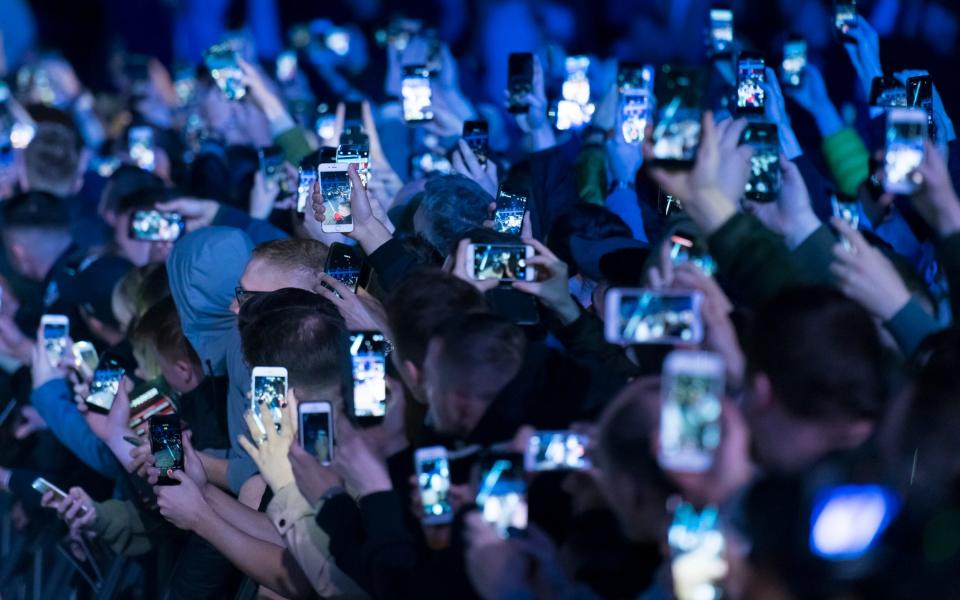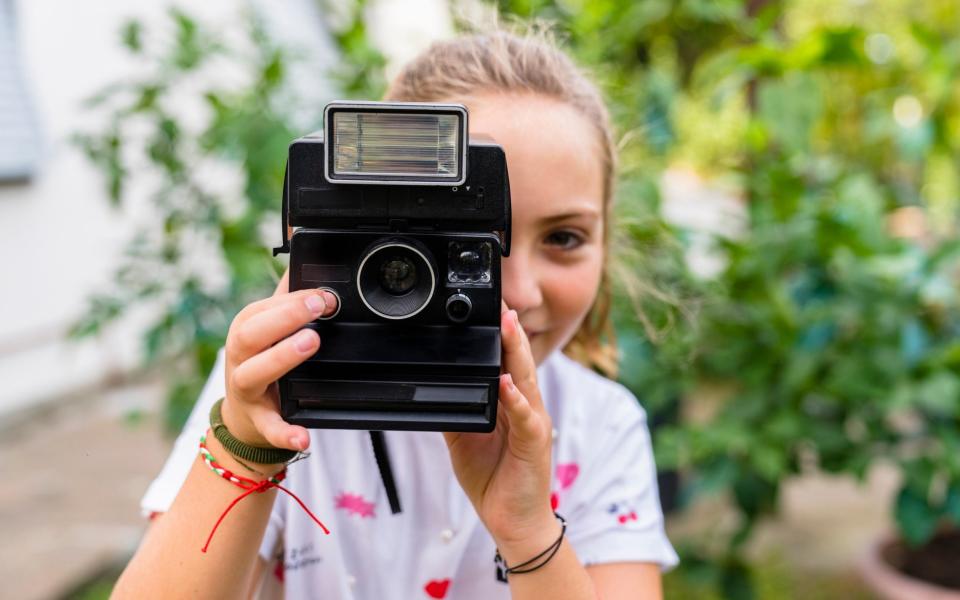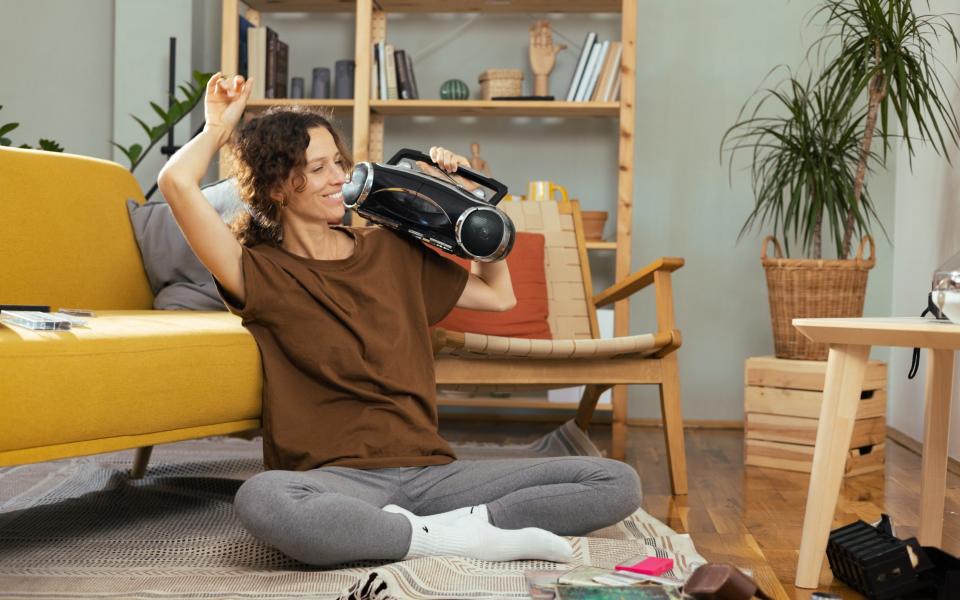‘I’m Gen Z but I miss the good old days of flip phones and Sony Walkmans’

As a child in the early noughties, few Saturday activities quite matched the thrill of a family trip to HMV or Blockbuster Video. Scanning rows of colourful covers for that evening’s entertainment was a treat, as was arriving home with a new tape to watch (and re-watch). But the pleasure of this exercise – like that of filling my portable CD player with a new disc, or waiting for camera film to be developed – was soon forgotten as the digital age evolved.
Our family Blockbuster trips soon became redundant, replaced first by cursory flicks through our home DVD collection, later by Netflix. My long-treasured CD player, and its accompanying stack of Spice Girls albums, was disregarded as I bought my first iPod, and later my Spotify library grew.
There was a sense of limited choice then that our current cosmic internet lacks. My siblings and I would take home a small pile from the library rather than scour Apple Books; we would fill our CD players with discs swapped with friends; we’d take turns playing pixelated games and experimenting with Microsoft Paintbrush on the family computer.

While our online world was broadened by the launch of YouTube in 2005, our digital choice remained restricted compared with that of today’s iPad kids. But, as a seven-year-old, I was content with my digital lot.
Fast-forward five years and I was among the first generation of children using social media. In my final year of primary school I spent my piggy bank savings on a £40 neon pink flip phone. As I started secondary I created my first Facebook account and, soon after, in possession of my mum’s old iPhone, joined the burgeoning communities of Instagram and Twitter.
Digital natives
Along with the rest of my generation, I quickly found myself growing up in a new world of digital abundance; an inedible Wonka’s Chocolate Factory. Technologically speaking, we had it all: where our parents had dial-up internet and four television channels, we had entertainment on tap, apps for everything, endless streams of the latest music and constant connectivity via social media.
So perhaps it’s ungrateful that, despite my sophisticated inventory of apps and devices, I often find myself missing the simplicity of analogue technology.
At the first pop concert I attended, for example (Girls Aloud, if you’re wondering), I was phone-free and spent the night very much in the moment, dancing with my mum. Go to a gig nowadays and you will see much of the audience watching the artist through their phone camera for the sake of an Instagram story.

This is something I too have been guilty of because, as an older member of the Gen Z cohort, I am part of the generation of “digital natives” that have grown up online. And it’s easy to see how all-in-one smartphones have come to dominate – and not simply enhance – our lives.
The reality is that while smartphones have revolutionised and democratised many areas of our lives, they also take us away from the present. “Phubbing” – the act of ignoring someone you’re with and giving attention to your mobile phone instead – might once have been seen as socially unacceptable, but it is now something we encounter every day.
Constant comparison
Social media flung us into a world of constant social comparison and fear of missing out (Fomo), and the detrimental effect this has had on our mental health is well documented. It is a minefield for parents, whose children could be a few finger taps away from harmful content they’re unlikely to encounter offline. Plus, in our “always-on” world where the internet is constantly fighting for our attention, it is nearly impossible to switch off. I am pretty sure my smartphone, with its constant distractions, has diminished my attention span over the years.
And I am not alone. Driven by nostalgia for a more rudimentary era, many young people are now ditching modern-day gadgets for the comparably primitive staples of the early 2000s. Sales of older technology – think digital and film cameras, flip phones, cassette tapes, Polaroids, Walkmans – have risen in recent months, thanks to an online revival. According to the BBC, searches on eBay for “vintage” digital cameras rose by 13 per cent in the last three months of 2022.

Leading this trend are my fellow Gen Z-ers, particularly those zoomers born in the early 2000s. On TikTok, where teenagers are recording themselves excitedly unboxing 90s-style Nokias, the hashtag “flipphone” has 620 million views. Some describe how they have embraced an offline “flip phone revolution”: one 18-year-old TikTok influencer said that when she goes out, she takes with her a basic flip phone with no internet access because “everything that leads to us having a bad time stems from our phone”.
On Twitter, an account dedicated to “retro tech” nostalgia, @RetroTechDreams, has amassed nearly 100,000 followers since last summer. Its photos of bulky 90s computers and CD collections are met with comments like “those were the days” and “life was better”.
A simpler time
According to Rex Woodbury, a Gen Z culture expert and author of the Digital Native blog on Substack, the trend – which he sees “everywhere from the embrace of vinyl to wired headphones to Walkmans” – reveals a lot about the younger generation’s relationship with technology.
He sees them as embracing a time “when you could leave the house and meet up with friends and be present in each other’s company, not consistently checking your emails or hitting refresh on Instagram and Snapchat to see how many people are thinking of you. I think people just yearn for that simpler time, but they also realise that there is no going back to it.”
Woodbury sees this embrace of retro tech as both sentimental and practical. “There’s something romantic about listening to music without getting the ding of notifications on your phone, but I also think there’s something that people like around physical, tactile products. So much of what we see or buy or interact with is online.”

This tangibility is something I miss too – but many of those sentimentalising a bygone “analogue” era are teenagers who have only ever known a world of iPhones and algorithms. Woodbury recently came across a TikTok video in which the user imagined life without a smartphone. “All the comments were so interesting,” he says. “Everyone said, ‘Oh my gosh, my life would be so much better.’ One person said, ‘I didn’t know what insecurities were until I got my first iPhone.’”
Teenage rebellion
So I can understand why we seem to be witnessing a teenage rebellion of sorts, albeit on a small scale, against modern technology. I sometimes tell my parents I am envious of their smartphone-free early 20s, when their meals, conversations and parties weren’t punctuated by an endless grab for phones.
Nowadays, it seems there is little in the way of boredom that comes from an absence of distraction and entertainment; the sort of boredom that produces endless creativity. That mental muscularity doesn’t seem as present nowadays, or as necessary, in a world where TikTok offers hours of free stimulation.
In a sense we were the guinea pigs, learning the ropes of our always-on world from scratch alongside our parents, with few guidelines to follow. The new social media world was seductive and exciting for us as teenagers who, perhaps naively, began to overshare on Twitter and Instagram, lacking the knowledge we have today about protecting ourselves online.
The dopamine hit that came from Instagram likes was addictive to us as teen girls who were desperate for validation – but we also knew, I think, that there was something unhealthy about this new social landscape that encouraged comparison and narcissism. Getting enough “likes” came with a momentary spike in self-worth, but a floundering Instagram selfie produced the opposite effect.

Plus, being among the first children to experiment with the internet meant we were also the first to find ourselves in its dark recesses. I knew children who were accessing violent porn from the age of 11. And for some teenage girls with changing bodies, social media – the algorithms of which promoted anything from self-harm to diet restriction – could be lethal.
It was only in my 20s, when I began to clear out my old Instagram posts, that I began to fully appreciate the extent to which I had spent my teenage years online. Looking back, it’s easy to see how publicly sharing the minute details of our lives wasn’t a great idea, given how many of our teenage mishaps are probably best left in the past.
How damaging it must have been for us, as self-conscious teenagers, to spend our formative years performing and self-branding in this buzzing online arena. Removing ourselves from this virtual world was obviously possible, but it would have led to social isolation: this was where our peers were, our conversations, our event invitations – everything.
Digital diet
While I am now far less active on social media than I was as a child, that threat of social isolation means I still find it almost impossible to stop using it – and by extension my smartphone – completely. I try to limit the amount of time I spend using apps such as Instagram and TikTok, regularly deleting them for long periods before re-downloading them, and my boyfriend and I try to leave our phones at home when we can.
But any “digital diet” is, sadly, short-lived. The Fomo is always there, whether you use social media or not. And it is easy to forget just how intertwined our phones have become with our daily lives: it is often where we work, bank and shop.
Woodbury thinks that dipping into a pre-smartphone era is something we could see more of as our world becomes more digitally connected. “People will become more purposeful and intentional about how they can carve out non-digital-era moments for themselves,” he says.
“We’ll probably have more phoneless work meetings, phoneless parties, phoneless dinners… maybe people will make a pact to have a digital detox for someone’s birthday party, or things like that. I talked to one Gen Z-er who has a digital camera and she threw a party where people were not allowed to have their phones and could only take photos on a digital or disposable camera. It was interesting, because she said it forced everyone to be in the moment.”
Perhaps embracing the era of “retro tech” is one way to keep sane in our exhaustingly hyperconnected world, counterintuitive as it might sound. This is something I try to do in tiny ways, preferring physical books to swiping through the Kindle app on my phone, and taking a disposable camera with me on holiday so as to collect physical memories and not just the homogeneous thumbnails that fill my photos app.
While it is unlikely I’ll be swapping Netflix for DVDs any time soon, maybe it would be worth digging out my old iPod, if just for a few minutes’ respite from those incessant notifications.

